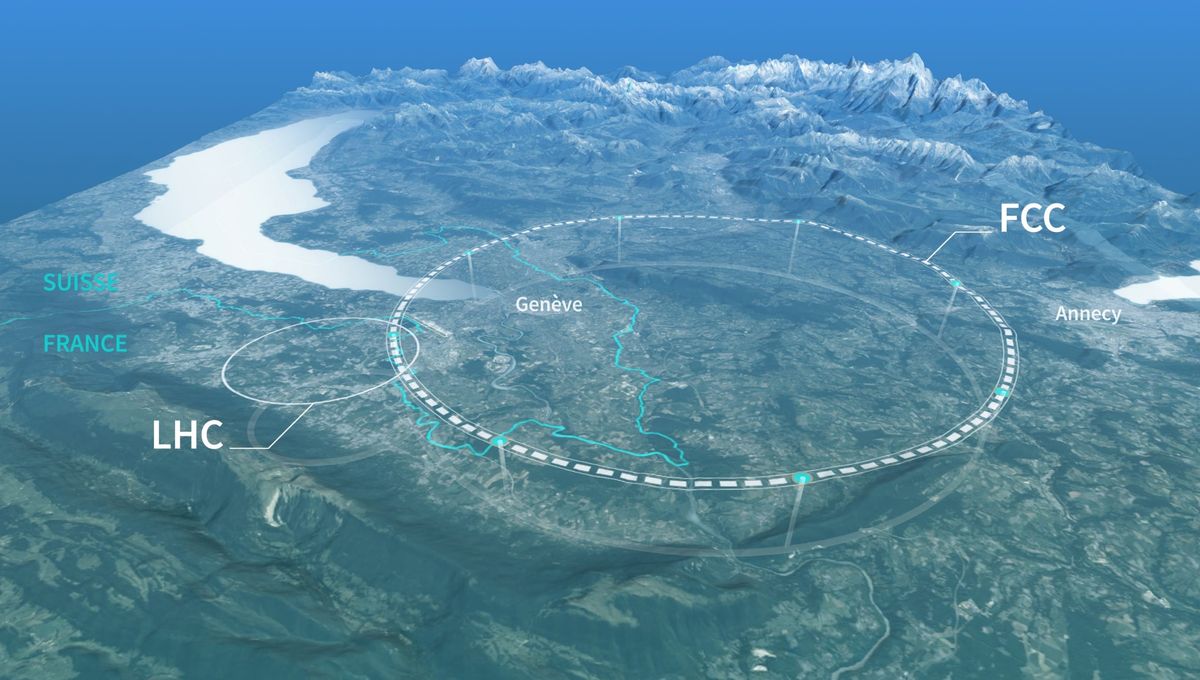
In early February, CERN’s restricted council held a special meeting to discuss one important item in its future: the next particle accelerator that they are going to build. CERN is home to the Large Hadron Collider (LHC), the most complex single machine in the world. The proposed design for the next-generation international collaboration particle smasher is the Future Circular Collider (FCC), and it is three times the length of the LHC.
The LHC is an extraordinary instrument. It has a 27-kilometer (16.77 miles) ring of superconducting magnets deep underneath Geneva, on the border between France and Switzerland. The LHC works thanks to the superconductive magnets being kept just above absolute zero surrounding its two giant tubes that are kept in an ultrahigh vacuum. It’s colder and emptier in there than in interstellar space.
Through the tubes, beams of protons (or sometimes heavy ions) travel at almost the speed of light, and they are made to collide inside one of the four experiments. The collisions create conditions the universe has not seen since shortly after the Big Bang, and a whole bunch of interesting particles are created. A crowning achievement was the discovery of the Higgs Boson, the particle that (simplistically) gives all the others mass.
Still, the LHC is limited. There are energies that cannot be achieved with such a machine – and for this reason, researchers have been considering what the next step might be. A few years back, CERN started investigating the proposal for the next particle accelerator, and the design settled upon after consultations among particle physicists across Europe and worldwide is an even bigger circular machine: the Future Circular Collider.
The proposed accelerator will be three times as long as the LHC at 90 kilometers (56 miles) and built twice as deep. If approved, it will begin construction in the early 2030s, start smashing electrons in the 2040s, and move to smashing protons in the 2070s.
The goal would be to explore the energies where direct evidence of dark matter and dark energy might be found. Those energies are simply beyond the LHC – the protons in its beams cannot be pushed beyond a certain limit. To go beyond this, one approach is to build a much bigger detector. That is all for a price tag of 15 billion Swiss francs, or about $17.2 billion.
The proposed plan is not without its critics, though. The project has been called a gamble because there is no guarantee it will succeed in providing evidence of the elusive dark matter and dark energy, which the LHC hasn’t yet. The same could have been argued about the LHC and the discovery of the Higgs Boson.
Of course, the discovery of that particle is not the LHC’s only success. In its first 10 years of operation, almost 3,000 scientific papers were published from its experiments – an enormous impact on our understanding of particle physics.
Some scientists, policymakers, and media have also called out the cost of the proposed facilities as being a waste of money, rather than considering it as an investment in the building and manufacturing industries across all the countries that are part of CERN. CERN is also the birthplace of the World Wide Web, so you are only reading this thanks to an investment in the organization.
Another criticism is that the money should be spent on environmental projects to mitigate the climate crisis. Beyond the erroneous assumption that the two are mutually exclusive, the European Union – which includes many CERN members – actually spent almost 100 times as much as the cost of the proposed plan on fossil fuel subsidies in 2022.
Ultimately, the decision of whether the project is what CERN needs rests on the countries that pay into the membership of CERN. A study into the feasibility of the FCC will be completed next year. In 2026, the European Strategy for Particle Physics will be updated, which might influence plans. If the plans are sound, the FCC could be approved in 2028 and a new generation of particle physics could begin.
Source Link: Enormous Next-Generation Particle-Smasher Proposed To Hunt The Dark Universe